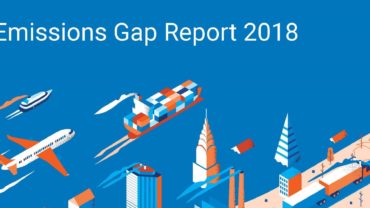Global emissions are on the rise as national commitments to combat climate change come up short.
In fact, the gap between the climate ambitions of the world and the effort needed to reach the targets in the Paris Agreement has increased.
These findings along with a sweeping review of climate action and the latest measurements of global emissions are the key findings of the 2018 Emissions Gap Report published today.
The report annually presents a definitive assessment of the so-called ’emissions gap’ – the gap between anticipated emission levels in 2030, compared to levels consistent with a 2°C / 1.5°C target.
UNEP DTU Partnership coordinates the flagship report from UN Environment, and UNEP DTU Partnership Director John Christensen, along with several other UNEP DTU Partnership scientists, are among the report’s main authors.
Insufficient commitments
Evidence outlined here, just days before the start of the COP24 in Poland, show global emissions have reached historic levels at 53.5 GtCO2e, with no signs of decreasing.
Increased emissions and lagging action means the gap number in this year’s report is larger than ever. Translated into climate action, the authors conclude nations must triple their ambition to meet the 2°C and to meet 1.5°C.
“The commitments given by the countries of the world in the Paris agreement are insufficient. Technically, it is still possible to ensure that global warming does not exceed two degrees, and ideally stays below 1.5 so we avoid the worst consequences, but unfortunately it looks very difficult.
We need to collectively accelerate implementation of existing solutions, increase ambitions, and set concrete new targets to further reduce greenhouse gas emissions,” says John Christensen, who has been part of all COP negotiations as a representative of the United Nations Environment Program.
Analysis and a review of progress against national commitments under the Paris Agreement makes it clear that the current pace of national action is insufficient to meet the Paris targets.
“There is both a big gap between what the world’s countries have promised to do, and what it is needed, and another one between the promises and so what is actually being done,”
John Christensen says.
Presenting the options for future climate action
A continuation of current trends will likely result in global warming of around 3°C by the end of the century, with continued temperature rises after that, according to the report findings.
“If the IPCC report represented a global fire alarm, this report is the arson investigation,” says UN Environment Deputy Executive Director Joyce Msuya.
“The science is clear; for all the ambitious climate action we’ve seen – governments need to move faster and with greater urgency. We’re feeding this fire while the means to extinguish it are within reach.”
The Emissions Gap Report differs from many other climate reports because it not only brings bad news but like previous year’s releases, this year’s report presents some of the most important options for reaching our climate goals. It documents that if there is political will, the goals can be achieved with existing solutions and technology.
It points to the need for all countries to not only achieve their commitments in the Paris agreement by 2030 but also to dramatically increase their ambitions within the next two years.
To fill this void, the 2018 Emissions Gap Report offers new insight into what meaningful climate action will look like. Through new analysis of global emissions in the context of fiscal policy, the current pace of innovation and an exhaustive review of climate action from the private sector and sub-national level, authors offer a roadmap for implementing the type of transformative action required to maximize potential in each of these sectors.
The solutions already exist
The good news is that the technical solutions needed to achieve the goals and reduce the emission of greenhouse gases adequately already exist. These are technologies that not only will help the climate, but will also contribute positively to the achievement of several of the 17 Sustainable Development Goals.
The 2018 Emissions Gap Report points to three areas in particular where existing technology can make a difference: Sustainable energy, energy efficient technology and transport, and a stop for deforestation.
In order for the full potential of climate-friendly technology to be reached, the report points to issues of fiscal policy, that in many countries needs to be geared to the necessary transformation to low-carbon economies.
“There is a need for political visions for how our society and life will be in a climate-friendly future. Of course, a change of the magnitude that this report and global climate challenges in general calls for takes time, but we have to get moving. There is simply no alternative,” concludes John Christensen

